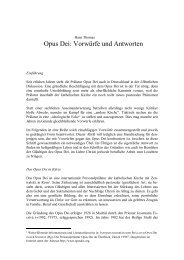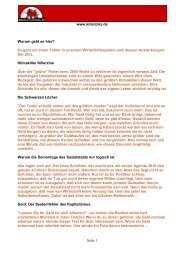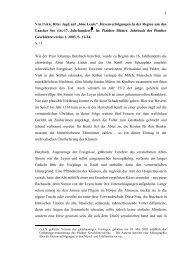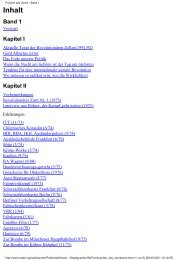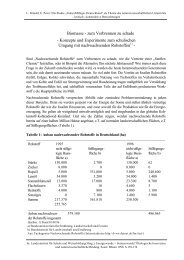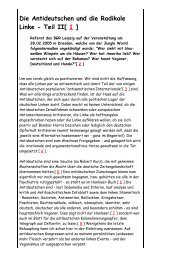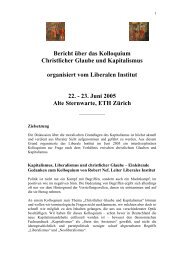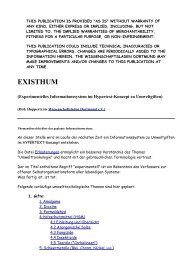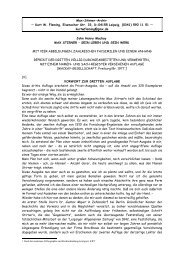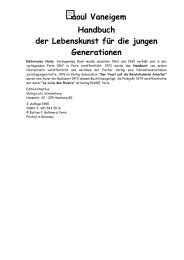- Seite 1 und 2: Debian GNU/Linux Anwenderhandbuch F
- Seite 3 und 4: Inhaltsverzeichnis Über dieses Buc
- Seite 5 und 6: 3.11.2. Zugriffsrechte ............
- Seite 7 und 8: 5.3.2. gdm - GNOME Display Manager.
- Seite 9 und 10: 6.8.6.2. Mouse Properties .........
- Seite 11 und 12: 8.1.1.2. Samba Integration.........
- Seite 13 und 14: 10.3. acroread.....................
- Seite 15 und 16: 18.1.5. hdparm.....................
- Seite 17 und 18: 20.5.1.6. Apache Webserver - CGI...
- Seite 19 und 20: Tabellenverzeichnis 4-1. RPM / DEB
- Seite 21 und 22: 2-89. taskselect ..................
- Seite 23 und 24: 6-38. Capplet Dialog...............
- Seite 25 und 26: 15-5. X-CD-Roast...................
- Seite 27 und 28: 20-79. Kategorie Hardware - Netzwer
- Seite 29 und 30: Copyright und Lizenz Copyright (c)
- Seite 31 und 32: Kapitel 1. Linux, Debian, Freie Sof
- Seite 33 und 34: Kapitel 1. Linux, Debian, Freie Sof
- Seite 35 und 36: Urknall 0.01 0.02 3. Juli 1991 Kapi
- Seite 37: 0.95 0.96 Kapitel 1. Linux, Debian,
- Seite 41 und 42: Kapitel 1. Linux, Debian, Freie Sof
- Seite 43 und 44: Debian 0.91 Debian 0.93R5 Debian 0.
- Seite 45 und 46: Kapitel 1. Linux, Debian, Freie Sof
- Seite 47 und 48: Debian 3.0 Security announcements
- Seite 49 und 50: Kapitel 1. Linux, Debian, Freie Sof
- Seite 51 und 52: Kapitel 1. Linux, Debian, Freie Sof
- Seite 53 und 54: Integration Quellcode Hohe Qualitä
- Seite 55 und 56: Stormix Demudi Tomukas Progeny Open
- Seite 57 und 58: Kapitel 1. Linux, Debian, Freie Sof
- Seite 59 und 60: Kapitel 1. Linux, Debian, Freie Sof
- Seite 61 und 62: 1.6.1. Internet Kapitel 1. Linux, D
- Seite 63 und 64: Autor: Ronneburg, Frank Datum/Seite
- Seite 65 und 66: Kapitel 2. Installation von Debian
- Seite 67 und 68: 2.7. Backup Kapitel 2. Installation
- Seite 69 und 70: Abbildung 2-2. AmigaOS - HDToolBox
- Seite 71 und 72: 2.8.3. alpha 2.8.4. powerpc Kapitel
- Seite 73 und 74: Kapitel 2. Installation von Debian
- Seite 75 und 76: Kapitel 2. Installation von Debian
- Seite 77 und 78: Kapitel 2. Installation von Debian
- Seite 79 und 80: 2.9.3. alpha Kapitel 2. Installatio
- Seite 81 und 82: Kapitel 2. Installation von Debian
- Seite 83 und 84: Kapitel 2. Installation von Debian
- Seite 85 und 86: Abbildung 2-19. Release Information
- Seite 87 und 88: aufsteigend nach der eingestellte A
- Seite 89 und 90:
Kapitel 2. Installation von Debian
- Seite 91 und 92:
Kapitel 2. Installation von Debian
- Seite 93 und 94:
o create a new empty DOS partition
- Seite 95 und 96:
Kapitel 2. Installation von Debian
- Seite 97 und 98:
Kapitel 2. Installation von Debian
- Seite 99 und 100:
Kapitel 2. Installation von Debian
- Seite 101 und 102:
Wir gehen hier aber von der Install
- Seite 103 und 104:
Kapitel 2. Installation von Debian
- Seite 105 und 106:
Kapitel 2. Installation von Debian
- Seite 107 und 108:
Kapitel 2. Installation von Debian
- Seite 109 und 110:
Kapitel 2. Installation von Debian
- Seite 111 und 112:
Wählen Sie hier noch einmal die st
- Seite 113 und 114:
Abbildung 2-66. Zeitzone Kapitel 2.
- Seite 115 und 116:
Kapitel 2. Installation von Debian
- Seite 117 und 118:
Kapitel 2. Installation von Debian
- Seite 119 und 120:
Kapitel 2. Installation von Debian
- Seite 121 und 122:
Kapitel 2. Installation von Debian
- Seite 123 und 124:
Kapitel 2. Installation von Debian
- Seite 125 und 126:
Kapitel 2. Installation von Debian
- Seite 127 und 128:
Kapitel 2. Installation von Debian
- Seite 129 und 130:
Abbildung 2-90. Package Installatio
- Seite 131 und 132:
Kapitel 2. Installation von Debian
- Seite 133 und 134:
Kapitel 2. Installation von Debian
- Seite 135 und 136:
Kapitel 2. Installation von Debian
- Seite 137 und 138:
Kapitel 2. Installation von Debian
- Seite 139 und 140:
Kapitel 2. Installation von Debian
- Seite 141 und 142:
Kapitel 3. Betrieb Hat man dies ein
- Seite 143 und 144:
Kapitel 3. Betrieb CRTL-a, dann CTR
- Seite 145 und 146:
Kapitel 3. Betrieb Um Ihren Rechner
- Seite 147 und 148:
Kapitel 3. Betrieb Beispielsweise s
- Seite 149 und 150:
-rw-r--r-- 1 root root 119 Nov 02 1
- Seite 151 und 152:
Kapitel 3. Betrieb vielmehr den Dat
- Seite 153 und 154:
ash-2.03$ rm testdatei rm: schreibg
- Seite 155 und 156:
Kapitel 3. Betrieb einfache Alterna
- Seite 157 und 158:
System angemeldet haben. Systemweit
- Seite 159 und 160:
Kapitel 3. Betrieb Adding ‘divers
- Seite 161 und 162:
Kapitel 3. Betrieb Altgediente Prog
- Seite 163 und 164:
Kapitel 3. Betrieb --after-date=DAT
- Seite 165 und 166:
Kapitel 3. Betrieb Das Device /dev/
- Seite 167 und 168:
3.17. Links Kapitel 3. Betrieb sind
- Seite 169 und 170:
Kapitel 3. Betrieb aufwendigen graf
- Seite 171 und 172:
• Pfeiltasten - Mit den Pfeiltast
- Seite 173 und 174:
• n - sucht nochmal in der gleich
- Seite 175 und 176:
• /dev/scd0 - SCSI CD-ROM/Brenner
- Seite 177 und 178:
Kapitel 3. Betrieb einer Swap-Parti
- Seite 179 und 180:
Kapitel 3. Betrieb Das war zu erwar
- Seite 181 und 182:
Kapitel 4. Installation weiterer Pa
- Seite 183 und 184:
Kapitel 4. Installation weiterer Pa
- Seite 185 und 186:
4.2.1. Access 4.2.2. Update 4.2.3.
- Seite 187 und 188:
4.2.4. Install 4.2.5. Config 4.2.6.
- Seite 189 und 190:
oot-floppies depends on slang1-pic
- Seite 191 und 192:
file cdrom http ftp copy Kapitel 4.
- Seite 193 und 194:
upgrade dist-upgrade install remove
- Seite 195 und 196:
Reading Package Lists... Done Build
- Seite 197 und 198:
Kapitel 4. Installation weiterer Pa
- Seite 199 und 200:
Kapitel 4. Installation weiterer Pa
- Seite 201 und 202:
stats Kapitel 4. Installation weite
- Seite 203 und 204:
depends pkgnames dotty 4.3.7. conso
- Seite 205 und 206:
n + oder SPACE - oder TAB U c oder
- Seite 207 und 208:
PFEIL-OBEN RETURN ^ + - i d v u g s
- Seite 209 und 210:
Kapitel 4. Installation weiterer Pa
- Seite 211 und 212:
Kapitel 4. Installation weiterer Pa
- Seite 213 und 214:
Kapitel 4. Installation weiterer Pa
- Seite 215 und 216:
Kapitel 4. Installation weiterer Pa
- Seite 217 und 218:
4.4. dpkg Kapitel 4. Installation w
- Seite 219 und 220:
4.5.1. tasksel Kapitel 4. Installat
- Seite 221 und 222:
Kapitel 4. Installation weiterer Pa
- Seite 223 und 224:
Kapitel 4. Installation weiterer Pa
- Seite 225 und 226:
4.6.4. gmc Kapitel 4. Installation
- Seite 227 und 228:
4.6.6. ssh Kapitel 4. Installation
- Seite 229 und 230:
XShells -- shells (xterm, rxvt, ...
- Seite 231 und 232:
RPM DEB Aktion Kapitel 4. Installat
- Seite 233 und 234:
Generation of pilot-address_0.3.0-2
- Seite 235 und 236:
svga Kapitel 5. X11 Wenn Sie ledigl
- Seite 237 und 238:
Kapitel 5. X11 Weiterhin ist es wic
- Seite 239 und 240:
Kapitel 5. X11 Stellen Sie nun unte
- Seite 241 und 242:
Kapitel 5. X11 Unter „modeselecti
- Seite 243 und 244:
• Allow server to be killed with
- Seite 245 und 246:
Depth 16 Modes "1600x1200" "800x600
- Seite 247 und 248:
Kapitel 5. X11 oder /dev/ttyS1 ange
- Seite 249 und 250:
Kapitel 5. X11 Im nächsten Schritt
- Seite 251 und 252:
a number of SVGA chipsets. On some
- Seite 253 und 254:
5.1.3. anXious You must be root to
- Seite 255 und 256:
Kapitel 5. X11 anXious kann das Pro
- Seite 257 und 258:
Kapitel 5. X11 Debian GNU/Linux ent
- Seite 259 und 260:
Kapitel 5. X11 Im nächsten Schritt
- Seite 261 und 262:
Kapitel 5. X11 Wenn Sie eine Maus m
- Seite 263 und 264:
Kapitel 5. X11 Hier nun die Auswahl
- Seite 265 und 266:
Kapitel 5. X11 Wählen Sie hier die
- Seite 267 und 268:
Wählen Sie hier aus, mit wie viel
- Seite 269 und 270:
Kapitel 5. X11 Sie können nun ermi
- Seite 271 und 272:
Stellen Sie hier die gewünschte Au
- Seite 273 und 274:
Hiermit ist die Konfiguration abges
- Seite 275 und 276:
5.3.2.1. Der GDM-Daemon Kapitel 5.
- Seite 277 und 278:
5.3.2.3.3. Der „Face Browser“ K
- Seite 279 und 280:
Chooser DefaultPath DisplayInitDir
- Seite 281 und 282:
UserAuthFBDir UserAuthFile AllowRoo
- Seite 283 und 284:
MaxPendingIndirect MaxSessions MaxW
- Seite 285 und 286:
Icon LocaleFile Logo Quiver SystemM
- Seite 287 und 288:
NAME=gdm DESC="GNOME Display Manage
- Seite 289 und 290:
Kapitel 5. X11 Es gibt drei Ansatzp
- Seite 291 und 292:
$ xlsfonts -adobe-courier-bold-i-no
- Seite 293 und 294:
--16:18:19-- http://www.microsoft.c
- Seite 295 und 296:
Kapitel 5. X11 Als Benutzer können
- Seite 297 und 298:
Kapitel 6. GNOME Dieser Abschnitt
- Seite 299 und 300:
Abbildung 6-2. Beispiel für GNOME
- Seite 301 und 302:
Abbildung 6-4. Rahmenstil ICE Kapit
- Seite 303 und 304:
Kapitel 6. GNOME Maus für die Emul
- Seite 305 und 306:
Kapitel 6. GNOME Für das Einfügen
- Seite 307 und 308:
Kapitel 6. GNOME bietet, jedoch kom
- Seite 309 und 310:
6.4.3. Desktop-Bereiche Kapitel 6.
- Seite 311 und 312:
Kapitel 6. GNOME Verzeichnisansicht
- Seite 313 und 314:
6.5.4. Kopieren und Verschieben von
- Seite 315 und 316:
auf das Symbol einer mit einer Anwe
- Seite 317 und 318:
6.5.8. Ändern der Einstellungen im
- Seite 319 und 320:
6.5.8.3. VFS Abbildung 6-19. VFS-Ei
- Seite 321 und 322:
6.5.9. Übersicht über die Menübe
- Seite 323 und 324:
Kapitel 6. GNOME • Ziehen einer P
- Seite 325 und 326:
Kapitel 6. GNOME Das Dialogfeld Glo
- Seite 327 und 328:
Kapitel 6. GNOME Browse können Sie
- Seite 329 und 330:
6.6.4. This Panel Properties Kapite
- Seite 331 und 332:
6.7.2. Verwenden des Menü-Editors
- Seite 333 und 334:
Kapitel 6. GNOME Sie können das Co
- Seite 335 und 336:
Kapitel 6. GNOME Anmeldepaßwort ei
- Seite 337 und 338:
6.8.2.4. Window Manager Kapitel 6.
- Seite 339 und 340:
Kapitel 6. GNOME Ihnen gewünschte
- Seite 341 und 342:
Mit dem Schieberegler Duration kön
- Seite 343 und 344:
Für die Tastatur stehen Ihnen zwei
- Seite 345 und 346:
Abbildung 6-36. Capplet Startup Pro
- Seite 347 und 348:
Abbildung 6-37. Capplet Application
- Seite 349 und 350:
Kapitel 6. GNOME Mit dem Capplet MD
- Seite 351 und 352:
Kapitel 6. GNOME jeweiligen Kompone
- Seite 353 und 354:
Abbildung 6-44. MEMLoad Applet Kapi
- Seite 355 und 356:
6.9.3. Network 6.9.4. Utility Kapit
- Seite 357 und 358:
Kapitel 6. GNOME Wenn Sie nicht üb
- Seite 359 und 360:
Kapitel 6. GNOME dargestellt. Wenn
- Seite 361 und 362:
Abbildung 6-54. GNOME CD Player Pro
- Seite 363 und 364:
6.11. GNOME Calendar 6.11.1. Einfü
- Seite 365 und 366:
Abbildung 6-57. GNOME Calendar Pref
- Seite 367 und 368:
Kapitel 6. GNOME TIP: Das Erstellen
- Seite 369 und 370:
Kapitel 6. GNOME Ansicht Month werd
- Seite 371 und 372:
6.11.4. Erstellen eines neuen Termi
- Seite 373 und 374:
Kapitel 7. Internet 7.1. Modem Ohne
- Seite 375 und 376:
Kapitel 7. Internet Provider überm
- Seite 377 und 378:
Kapitel 7. Internet | ( ) Pulse | |
- Seite 379 und 380:
Kapitel 7. Internet tail -f /var/lo
- Seite 381 und 382:
Mar 7 10:49:12 debian kernel: HiSax
- Seite 383 und 384:
Kapitel 7. Internet In dieser zweit
- Seite 385 und 386:
start-stop-daemon -/-start -/-quiet
- Seite 387 und 388:
7.3.2. Mozilla Kapitel 7. Internet
- Seite 389 und 390:
Kapitel 7. Internet Starten Sie lyn
- Seite 391 und 392:
[---Press return---] Kapitel 7. Int
- Seite 393 und 394:
Kapitel 7. Internet Hier die Frage,
- Seite 395 und 396:
7.4.1. mutt Kapitel 7. Internet Vie
- Seite 397 und 398:
# that will be used by the program
- Seite 399 und 400:
-V *-version -S, --smtphost set SMT
- Seite 401 und 402:
-p *-protocol Kapitel 7. Internet a
- Seite 403 und 404:
Kapitel 7. Internet „Klappen“ S
- Seite 405 und 406:
Kapitel 7. Internet der Datenübert
- Seite 407 und 408:
7.5.2. ncftp Kapitel 7. Internet -r
- Seite 409 und 410:
• Oberfläche in vielen Sprachen,
- Seite 411 und 412:
7.6.3. Screem Kapitel 7. Internet W
- Seite 413 und 414:
Zeichen > eingeben. Kapitel 7. Inte
- Seite 415 und 416:
7.7. Verschlüsselung 7.7.1. PGP 7.
- Seite 417 und 418:
Kapitel 7. Internet Hier können Si
- Seite 419 und 420:
Comment: Weitere Infos: siehe http:
- Seite 421 und 422:
Kapitel 7. Internet Korrespondenzpa
- Seite 423 und 424:
8.1.1. Pakete Folgende Debian Paket
- Seite 425 und 426:
Kapitel 8. Drucken Der Scheduler ve
- Seite 427 und 428:
Kapitel 8. Drucken Eine Übersicht
- Seite 429 und 430:
pcl-840.ppd.gz HP DeskJet 840C, CUP
- Seite 431 und 432:
Kapitel 8. Drucken Alle Bereiche ü
- Seite 433 und 434:
8.1.7.2.3. Dokumentation Help an di
- Seite 435 und 436:
Kapitel 8. Drucken In diesem Beispi
- Seite 437 und 438:
Kapitel 8. Drucken Wenn der Drucker
- Seite 439 und 440:
Kapitel 8. Drucken Hier sollten zum
- Seite 441 und 442:
8.1.7.3.3. Verschlüsselung • Ser
- Seite 443 und 444:
8.2. apsfilter All None *.domain.co
- Seite 445 und 446:
Kapitel 8. Drucken Wenn Sie auf Ihr
- Seite 447 und 448:
Kapitel 8. Drucken Es folgt eine de
- Seite 449 und 450:
(Q) Quit Setup Your choice ? 2 Kapi
- Seite 451 und 452:
Kapitel 8. Drucken Wählen Sie nun
- Seite 453 und 454:
the printer, you want to print on,
- Seite 455 und 456:
_/ _/ _/ _/ _/ _/_/_/_/ _/_/_/ _/_/
- Seite 457 und 458:
Kapitel 8. Drucken Diese Veränderu
- Seite 459 und 460:
Kapitel 9. Grafik 9.1. The Gimp The
- Seite 461 und 462:
Kapitel 9. Grafik --nodata Lädt ke
- Seite 463 und 464:
Kapitel 9. Grafik Sie können die H
- Seite 465 und 466:
GIMP einscannen können. Kapitel 9.
- Seite 467 und 468:
Kapitel 9. Grafik Die Scripte sind
- Seite 469 und 470:
Kapitel 9. Grafik In der ersten Zei
- Seite 471 und 472:
Die Pinsel. Abbildung 9-15. The Gim
- Seite 473 und 474:
Kapitel 9. Grafik Sie erreichen den
- Seite 475 und 476:
Kapitel 9. Grafik • Standard-Bild
- Seite 477 und 478:
9.1.14.7. Directory Preferences Kap
- Seite 479 und 480:
9.1.15.3. Elliptische Auswahl Abbil
- Seite 481 und 482:
9.2. Scanner Kapitel 9. Grafik Wenn
- Seite 483 und 484:
# enable the next line if you want
- Seite 485 und 486:
9.2.3. xsane Kapitel 9. Grafik Im F
- Seite 487 und 488:
Abbildung 9-29. xsane scannen Kapit
- Seite 489 und 490:
Kapitel 9. Grafik Da xsane als Plug
- Seite 491 und 492:
9.3.1.1. Einstellungen Kapitel 9. G
- Seite 493 und 494:
Kapitel 9. Grafik „Open in Window
- Seite 495 und 496:
Kapitel 9. Grafik In dem dann ersch
- Seite 497 und 498:
Kapitel 10. Text Um Linux nicht nur
- Seite 499 und 500:
10.2. xpdf Kapitel 10. Text Nach ei
- Seite 501 und 502:
Prints out all command-line options
- Seite 503 und 504:
Kapitel 11. Kalkulation 11.1. Gnume
- Seite 505 und 506:
11.1.6. Bezüge Kapitel 11. Kalkula
- Seite 507 und 508:
Kapitel 12. Sound 12.1. Soundkarte
- Seite 509 und 510:
Kapitel 12. Sound Rechts davon sehe
- Seite 511 und 512:
Kapitel 12. Sound Das dazugehörige
- Seite 513 und 514:
Kapitel 12. Sound • CD Audio Play
- Seite 515 und 516:
-v, --version Print version number
- Seite 517 und 518:
Die herausragenden Features von Fre
- Seite 519 und 520:
Abbildung 12-8. Grip Kapitel 12. So
- Seite 521 und 522:
Kapitel 12. Sound Die Dateien werde
- Seite 523 und 524:
Kapitel 13. Modellbahnen Das hier v
- Seite 525 und 526:
13.4.1. erddcd 13.4.2. ddl 13.4.3.
- Seite 527 und 528:
Kapitel 13. Modellbahnen Im zweiten
- Seite 529 und 530:
Kapitel 14. TV und Video Auch der B
- Seite 531 und 532:
15.2.1. SCSI 15.2.2. IDE Kapitel 15
- Seite 533 und 534:
Kapitel 15. CD brennen Natürlich k
- Seite 535 und 536:
Abbildung 15-4. X-CD-Roast Kapitel
- Seite 537 und 538:
Kapitel 15. CD brennen Das Erstelle
- Seite 539 und 540:
Kapitel 15. CD brennen 539
- Seite 541 und 542:
Kapitel 16. Netzwerk Nun müssen Si
- Seite 543 und 544:
Enter the local domain name: (type
- Seite 545 und 546:
Kapitel 16. Netzwerk Das Kommando i
- Seite 547 und 548:
Kapitel 16. Netzwerk Wenn Sie nun e
- Seite 549 und 550:
Kapitel 16. Netzwerk Wenn ein Debia
- Seite 551 und 552:
Kapitel 17. Server-Dienste 17.1. Ap
- Seite 553 und 554:
LoadModule expires_module /usr/lib/
- Seite 555 und 556:
echo SERVER_SOFTWARE = $SERVER_SOFT
- Seite 557 und 558:
DATE_GMT DATE_LOCAL DOCUMENT_NAME D
- Seite 559 und 560:
17.2. FTP-Server Kapitel 17. Server
- Seite 561 und 562:
17.3. DHCP Kapitel 17. Server-Diens
- Seite 563 und 564:
host surimi { hardware ethernet 00:
- Seite 565 und 566:
17.4. Samba Kapitel 17. Server-Dien
- Seite 567 und 568:
Kapitel 17. Server-Dienste Als Erg
- Seite 569 und 570:
Kapitel 17. Server-Dienste gnosamba
- Seite 571 und 572:
Kapitel 17. Server-Dienste nun eine
- Seite 573 und 574:
Kapitel 18. Exotische Hardware In d
- Seite 575 und 576:
Kapitel 18. Exotische Hardware hdpa
- Seite 577 und 578:
Kapitel 18. Exotische Hardware 2.2
- Seite 579 und 580:
Kapitel 18. Exotische Hardware Akti
- Seite 581 und 582:
Kapitel 18. Exotische Hardware Jul
- Seite 583 und 584:
dr-xr-xr-x 1 root root 0 Jan 26 10:
- Seite 585 und 586:
18.2.4. Scanner-Konfiguration Kapit
- Seite 587 und 588:
Kapitel 18. Exotische Hardware Wenn
- Seite 589 und 590:
um die Daten auf Ihrem Rechner zu s
- Seite 591 und 592:
Kapitel 18. Exotische Hardware Weit
- Seite 593 und 594:
Kapitel 18. Exotische Hardware Übe
- Seite 595 und 596:
Kapitel 18. Exotische Hardware Sie
- Seite 597 und 598:
18.4. „Geräderte“ Mäuse Kapit
- Seite 599 und 600:
Kapitel 19. Systemadministration 19
- Seite 601 und 602:
Kapitel 19. Systemadministration In
- Seite 603 und 604:
19.2.1. date Kapitel 19. Systemadmi
- Seite 605 und 606:
19.2.2. rdate Kapitel 19. Systemadm
- Seite 607 und 608:
Kapitel 19. Systemadministration
- Seite 609 und 610:
19.3.2.6. Übersetzen der Module Ka
- Seite 611 und 612:
Kapitel 19. Systemadministration Mi
- Seite 613 und 614:
Kapitel 20. Systemkonfiguration mit
- Seite 615 und 616:
20.3. Kategorie Webmin Kapitel 20.
- Seite 617 und 618:
20.3.3. Webmin Konfiguration Kapite
- Seite 619 und 620:
20.3.3.2. Webmin Konfiguration - An
- Seite 621 und 622:
Kapitel 20. Systemkonfiguration mit
- Seite 623 und 624:
20.3.3.7. Webmin Konfiguration - Be
- Seite 625 und 626:
20.3.3.9. Webmin Konfiguration - In
- Seite 627 und 628:
20.3.3.12. Webmin Konfiguration - R
- Seite 629 und 630:
20.3.3.14. Webmin Konfiguration - W
- Seite 631 und 632:
20.3.4. Webmin Server Index Kapitel
- Seite 633 und 634:
zw. eine Gruppe, dieser verändert
- Seite 635 und 636:
20.4.2. Change Passwords Kapitel 20
- Seite 637 und 638:
Kapitel 20. Systemkonfiguration mit
- Seite 639 und 640:
Kapitel 20. Systemkonfiguration mit
- Seite 641 und 642:
20.5.1.1. Apache Webserver - Prozes
- Seite 643 und 644:
Kapitel 20. Systemkonfiguration mit
- Seite 645 und 646:
Kapitel 20. Systemkonfiguration mit
- Seite 647 und 648:
Kapitel 20. Systemkonfiguration mit
- Seite 649 und 650:
Kapitel 20. Systemkonfiguration mit
- Seite 651 und 652:
20.5.2. Postfix Kapitel 20. Systemk
- Seite 653 und 654:
Kapitel 20. Systemkonfiguration mit
- Seite 655 und 656:
20.5.2.4. Postfix Mailserver - Kano
- Seite 657 und 658:
20.5.2.7. Postfix Mailserver - Neu
- Seite 659 und 660:
20.5.2.9. Postfix Mailserver - Allg
- Seite 661 und 662:
20.5.2.11. Postfix Mailserver - SMT
- Seite 663 und 664:
20.5.2.13. Postfix Mailserver - Deb
- Seite 665 und 666:
Kapitel 20. Systemkonfiguration mit
- Seite 667 und 668:
Kapitel 20. Systemkonfiguration mit
- Seite 669 und 670:
Kapitel 20. Systemkonfiguration mit
- Seite 671 und 672:
Kapitel 20. Systemkonfiguration mit
- Seite 673 und 674:
Kapitel 20. Systemkonfiguration mit
- Seite 675 und 676:
Kapitel 20. Systemkonfiguration mit
- Seite 677 und 678:
Kapitel 20. Systemkonfiguration mit
- Seite 679 und 680:
Routing und Namesauflösung. Abbild
- Seite 681 und 682:
Abbildung 20-81. Kategorie Hardware
- Seite 683 und 684:
20.7. Andere In dieser Kategorie fi
- Seite 685 und 686:
Kapitel 20. Systemkonfiguration mit
- Seite 687 und 688:
• cb - Text der im -Tag von Tabel
- Seite 689 und 690:
Kapitel 21. Systemsicherheit Man so
- Seite 691 und 692:
Kapitel 21. Systemsicherheit Jede P
- Seite 693 und 694:
Kapitel 21. Systemsicherheit keine
- Seite 695 und 696:
Kapitel 21. Systemsicherheit werden
- Seite 697 und 698:
Kapitel 21. Systemsicherheit TCP Wr
- Seite 699 und 700:
Kapitel 21. Systemsicherheit Die Ü
- Seite 701 und 702:
Kapitel 21. Systemsicherheit wird,
- Seite 703 und 704:
21.2.3.5. E-Mail Kapitel 21. System
- Seite 705 und 706:
Kapitel 21. Systemsicherheit Unmitt
- Seite 707 und 708:
Kapitel 22. Weitere Infos 22.1. Abk
- Seite 709 und 710:
Kapitel 22. Weitere Infos exclude_p
- Seite 711 und 712:
Kapitel 22. Weitere Infos • expor
- Seite 713 und 714:
# And this option will make you 2 c
- Seite 715 und 716:
Kapitel 22. Weitere Infos Mängel i
- Seite 717 und 718:
22.7. Deutsche Tastatur mit X11 Kap
- Seite 719 und 720:
22.7.2. Warenzeichen Kapitel 22. We
- Seite 721 und 722:
9. Keine Auswirkungen auf andere Pr
- Seite 723 und 724:
Kapitel 22. Weitere Infos Folgenden
- Seite 725 und 726:
Kapitel 22. Weitere Infos dieser Li
- Seite 727 und 728:
Kapitel 22. Weitere Infos Die Verö
- Seite 729 und 730:
Kapitel 22. Weitere Infos The autho
- Seite 731 und 732:
Codenamen, 49 Common Gateway Interf
- Seite 733 und 734:
Interpreters, ?? IP-Nummer, 664 IPP
- Seite 735 und 736:
Pinguin, 40 Pipes, 166 poff, 379 po




